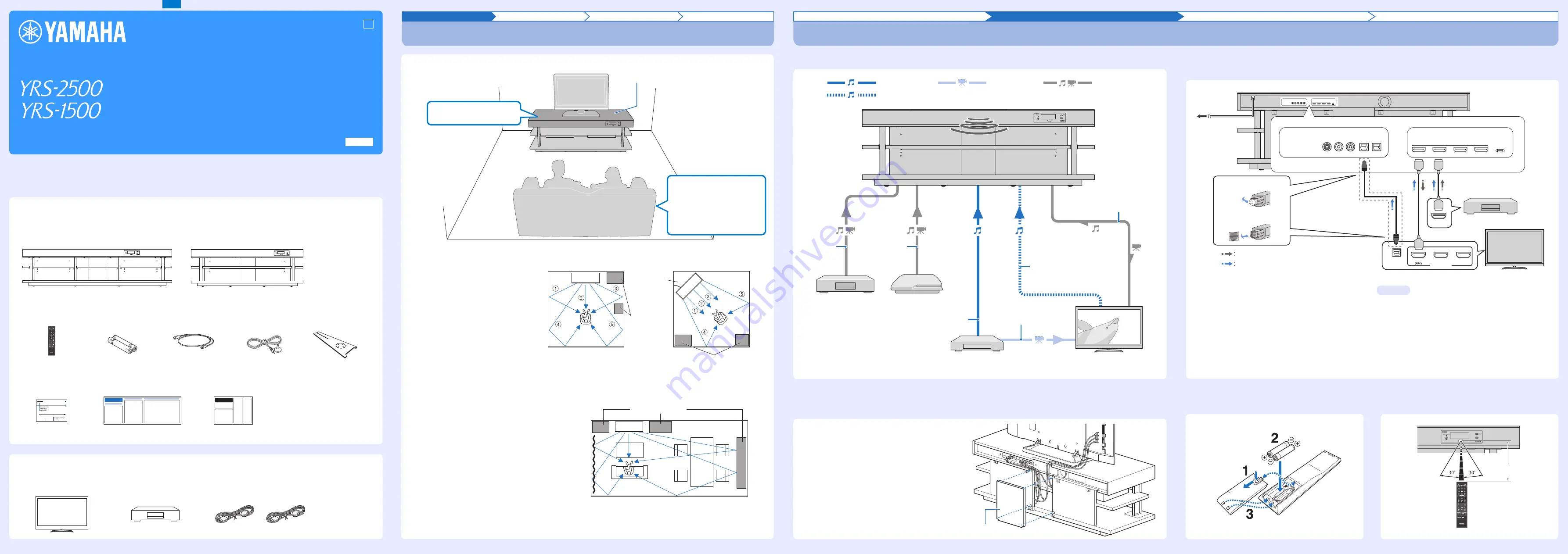
This Quick Reference Guide provides instructions for connecting a TV and BD/DVD player to this unit, applying settings, and playing
content. For more information on operations, refer to the Owner’s Manual.
Read the safety instructions on page 2 in the Owner’s Manual before using this unit. For instructions on how to operate or set the
external devices, refer to the owner’s manual supplied with each device.
In this manual, the YRS-1500 is used for illustrative purposes.
Surround sound TV stand
Quick Reference Guide
English
F
Supplied accessories
Before connecting, make sure you have received all of the following items.
YRS-2500
YRS-1500
The rack must be
assembled before it
can be used. Refer to
the Install Manual for
a list of parts and
assembly
instructions.
Remote control
Batteries
(AAA, R03, UM-4) (x2)
Optical cable (1.5 m)
IntelliBeam microphone
(6 m)
Cardboard
microphone stand
Owner’s Manual
Quick Reference Guide (this booklet)
Install Manual
Devices and cables required for connection
The following items are not supplied with this unit.
TV
BD/DVD player
HDMI cables (x2)
Installation
Connection
Settings
Playback
Installation
YRS-2500
YRS-1500
This unit creates surround effects by
reflecting sound beams off the walls of your
listening room. The arrows in the diagrams
on the right indicate the images of paths of
5-channel sound beams. To achieve desired
surround sound effects, install this unit
where there are no objects such as furniture
obstructing the path of sound beams.
Parallel installation
Corner installation
Objects,
such as
furniture
Objects, such as furniture
40° to 50°
1
Front left channel
2
Center channel
3
Front right channel
4
Surround left channel
5
Surround right channel
Install the unit in the center of
the left and right walls.
• The listening position (such as
sofa, etc.) should be located
at the front of the unit.
• The distance between the
listening position and the unit
should be more than 1.8 m.
Example for installing the unit in living room
• As sound beams normally pass through tables, tables are
not obstacles. And a cupboard installed facing the wall
reflects sounds.
• In a case of the listening room as shown in the illustration
on the right, adjusting the position of the right channel after
AUTO SETUP (as shown in “Carrying out AUTO SETUP for
appropriate surround effects” in this Quick Reference
Guide) enables to achieve more desired surround sound
effects. See page 48 in Owner's Manual.
• As the curtains absorb sounds, the sound features of the
listening room is different from the case with the curtain
opened and the case with the curtain closed. Using saving
settings function enables to save the best settings for each
case of listening room. See page 40 in Owner's Manual.
Objects, such as
furniture
Installation
Connection
Settings
Playback
Connection
When external devices such as a TV, BD/DVD player, and/or game console are connected, audio and video signals are transmitted as
shown below.
• Do not connect the power cable until all connections are completed.
• Do not use excessive force when inserting the cable plug. Doing so may damage the cable plug and/or jack.
■
Handling cables
■
Connecting a TV and BD/DVD player
For the cable connection, follow the procedure below. See page 19 in the Owner’s Manual when connecting other playback devices
such as a game console.
■
Preparing remote control
Audio connection
Video connection
Audio and video
connection
This unit:
Plays audio from TV broadcasts, BD/DVD discs, etc.
BD/DVD player
Satellite and cable TV tuner
(not HDMI-compatible)
TV:
Plays video from TV
broadcasts, BD/DVD player, etc.
Game console
(HDMI-compatible)
HDMI cable
HDMI cable
Optical cable
Video cable
HDMI cable
Optical cable
Use to connect a TV that does not
support audio return channel (ARC) to
this unit.
Audio from TV broadcast
(TVs that support Audio
Return Channel (ARC))
When placing playback devices on the rack,
remove the center rear panel and connect the
playback devices. Run cables through the
indented portion of the rack, and reattach the
center rear panel after all devices are connected.
If longer cables are used, excess portions can be
stored in the space between the center rear panel
and this unit.
Center rear panel
R
L
AUX1
AUX2
TV
OPTICAL
OUT (ARC)
IN1
IN2
IN3
HDMI
R
L
AUX1
AUX2
TV
OPTICAL
OUT (ARC)
IN1
IN2
IN3
HDMI
HDMI INPUT
OPTICAL
OUTPUT
1
2
3
HDMI
OUTPUT
BD/DVD player
TV
1. Remove the cap
2. Check the direction of
the plug
Video signals
Audio signals
1
2
3
To an AC wall
outlet
1.
HDMI cable (optional)
Input the digital audio/video signals from the BD/DVD player
to this unit.
2.
HDMI cable (optional)
Digital video from the BD/DVD player is displayed on the TV.
3
.
To an AC wall outlet
Audio Return Channel (ARC) supported TV
• Connect an HDMI cable to the audio return channel supported
jack (the jack with “ARC” indicated) on TV.
• Activate the HDMI control function of this unit so as to activate
the Audio Return Channel (ARC). See page 29 in the Owner’s
Manual.
What is Audio Return Channel (ARC)?
A function transmits digital audio signal output from TV to this unit
through an HDMI cable. By this function, an optical cable to
connect TV and this unit is not needed.
y
Tips
Use an optical cable when
connecting a TV that does not
support Audio Return Channel.
Installing the batteries
Battery × 2 (supplied)
(AAA, R03, UM-4)
Press down on
the arrow and
slide the cover in
the direction in
which it points.
Slide the cover back to close it.
Within 6 m
Operation range
© 2014 Yamaha Corporation
Printed in Indonesia ZM27730 [En]
En




















